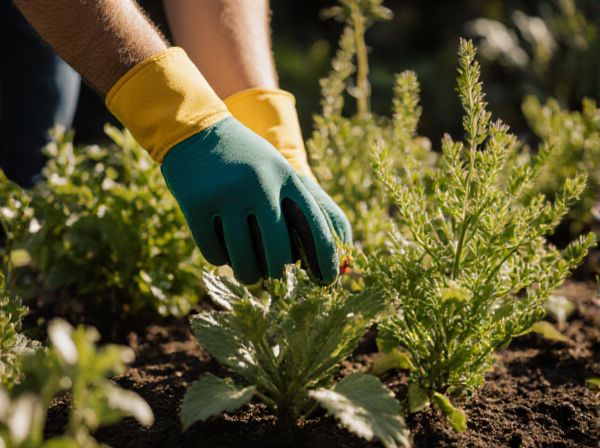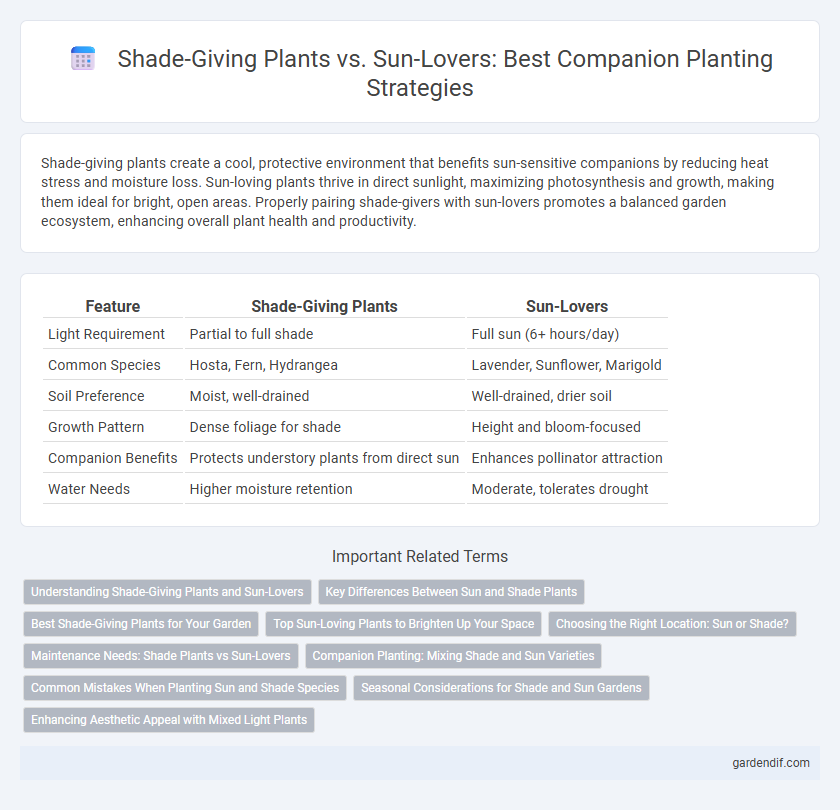
Shade-giving plants vs sun-lovers Illustration
Shade-giving plants create a cool, protective environment that benefits sun-sensitive companions by reducing heat stress and moisture loss. Sun-loving plants thrive in direct sunlight, maximizing photosynthesis and growth, making them ideal for bright, open areas. Properly pairing shade-givers with sun-lovers promotes a balanced garden ecosystem, enhancing overall plant health and productivity.
Table of Comparison
| Feature | Shade-Giving Plants | Sun-Lovers |
|---|---|---|
| Light Requirement | Partial to full shade | Full sun (6+ hours/day) |
| Common Species | Hosta, Fern, Hydrangea | Lavender, Sunflower, Marigold |
| Soil Preference | Moist, well-drained | Well-drained, drier soil |
| Growth Pattern | Dense foliage for shade | Height and bloom-focused |
| Companion Benefits | Protects understory plants from direct sun | Enhances pollinator attraction |
| Water Needs | Higher moisture retention | Moderate, tolerates drought |
Understanding Shade-Giving Plants and Sun-Lovers
Shade-giving plants thrive in low-light environments, often featuring large, broad leaves that efficiently capture limited sunlight, making them ideal companions for sun-sensitive species. Sun-lovers require at least six hours of direct sunlight daily, with adaptations like smaller, thicker leaves to reduce water loss under intense light. Understanding the distinct light preferences and physiological traits of shade-giving plants versus sun-lovers is crucial for successful companion planting and optimizing garden microclimates.
Key Differences Between Sun and Shade Plants
Shade-giving plants thrive in low-light environments with adaptations such as larger, thinner leaves to maximize photosynthesis, while sun-lovers prefer full sunlight and have thicker, smaller leaves to reduce water loss. Shade plants typically require less water and are more sensitive to intense heat, whereas sun-loving plants exhibit higher drought tolerance and require more direct sunlight for optimal growth. Understanding these key differences helps in choosing compatible companion plants that support each other's light and water needs, maximizing garden health and productivity.
Best Shade-Giving Plants for Your Garden
Best shade-giving plants for your garden include species like hostas, ferns, and astilbes, which thrive in low-light conditions and enhance garden aesthetics. These plants help create cool, shaded areas, reducing heat stress for both flora and garden visitors. Selecting shade-tolerant plants supports biodiversity and maintains soil moisture, promoting a healthier garden ecosystem.
Top Sun-Loving Plants to Brighten Up Your Space
Top sun-loving plants such as succulents, lavender, and marigolds thrive under direct sunlight, adding vibrant colors and textures to your garden or indoor space. These plants require at least six hours of full sun daily to grow healthy and produce blossoms that attract pollinators like bees and butterflies. Incorporating sun-loving species alongside shade-giving companions ensures a dynamic, visually appealing garden with varied microclimates supporting diverse plant life.
Choosing the Right Location: Sun or Shade?
Shade-giving plants thrive in low-light environments, making them ideal for north-facing gardens or areas shaded by trees and structures. Sun-loving plants require at least six hours of direct sunlight daily, thriving best in south-facing spots with minimal obstructions. Selecting the right location based on a plant's sunlight needs ensures optimal growth, health, and flowering, promoting a successful companion planting strategy.
Maintenance Needs: Shade Plants vs Sun-Lovers
Shade-giving plants typically require consistent moisture and nutrient-rich soil to thrive under low light conditions, while sun-loving plants demand well-drained soil and regular watering to endure intense sunlight. Maintenance for shade plants often involves monitoring humidity and protecting them from temperature extremes, whereas sun-lovers benefit from fertilizer applications that enhance their photosynthesis efficiency. Both types benefit from pruning, but shade plants need careful trimming to maintain airflow and prevent fungal growth.
Companion Planting: Mixing Shade and Sun Varieties
Companion planting benefits from mixing shade-giving plants like ferns and hostas with sun-lovers such as tomatoes and peppers to optimize garden microclimates. Shade plants help reduce heat stress and conserve soil moisture, supporting the growth of sun-sensitive companions. This synergy enhances plant health, boosts yield, and promotes biodiversity in home gardens.
Common Mistakes When Planting Sun and Shade Species
Mistakes such as planting sun-loving species in shaded areas or shade-tolerant plants in direct sunlight can lead to poor growth and reduced yields. Overcrowding shade plants without considering their light requirements often results in weak, leggy growth and increased susceptibility to diseases. Proper site assessment and matching plants to their ideal light exposure are critical for optimal companion planting success.
Seasonal Considerations for Shade and Sun Gardens
Shade-giving plants thrive in cooler, less intense light conditions, making them ideal for spring and fall gardens when sunlight is less harsh, while sun-lovers require full, direct sunlight, especially during summer for optimal growth. Seasonal considerations for companion planting involve selecting shade-tolerant species such as hostas and ferns to protect tender plants in early spring, contrasted with sun-loving crops like tomatoes and peppers that demand peak sunlight in summer months. Adjusting garden layouts seasonally ensures shade plants receive indirect light without wilting and sun-lovers gain sufficient exposure to maximize photosynthesis and yield.
Enhancing Aesthetic Appeal with Mixed Light Plants
Shade-giving plants such as ferns and hostas create lush, textured layers that contrast beautifully with sun-loving blooms like lavender and coneflowers, enhancing garden aesthetics through varied light preferences. Combining these plants optimizes visual interest by balancing dense foliage and vibrant colors, making garden spaces dynamic and inviting throughout the day. Strategic placement according to light requirements ensures healthier growth and prolonged blooming seasons, elevating the overall beauty and harmony of mixed light garden designs.
Shade-giving plants vs sun-lovers Infographic

 gardendif.com
gardendif.com